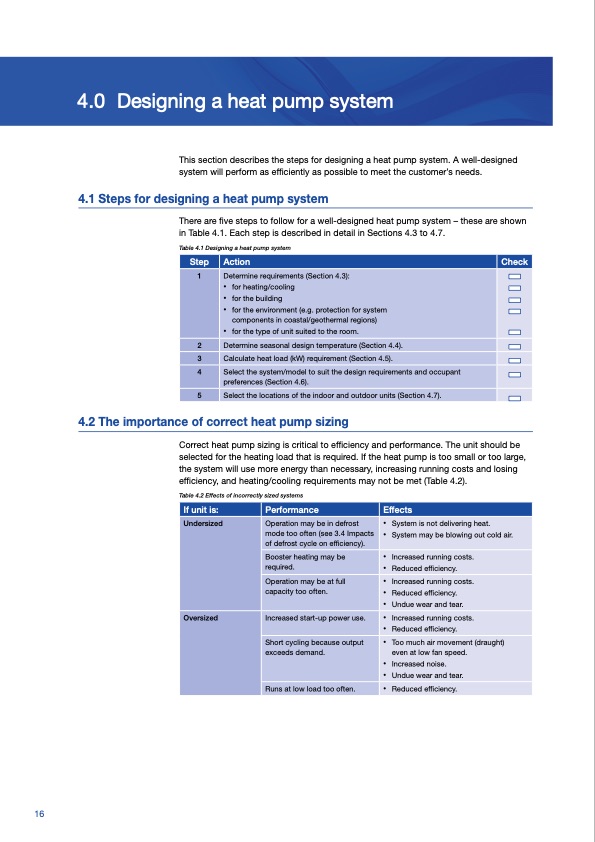
PDF Publication Title:
Text from PDF Page: 016
4.0 Designing a heat pump system This section describes the steps for designing a heat pump system. A well-designed system will perform as efficiently as possible to meet the customer’s needs. 4.1 Steps for designing a heat pump system There are five steps to follow for a well-designed heat pump system – these are shown in Table 4.1. Each step is described in detail in Sections 4.3 to 4.7. Table 4.1 Designing a heat pump system Step Action Check 1 Determine requirements (Section 4.3): • for heating/cooling • for the building • for the environment (e.g. protection for system components in coastal/geothermal regions) • for the type of unit suited to the room. 2 Determine seasonal design temperature (Section 4.4). 3 Calculate heat load (kW) requirement (Section 4.5). 4 Select the system/model to suit the design requirements and occupant preferences (Section 4.6). 5 Select the locations of the indoor and outdoor units (Section 4.7). 4.2 The importance of correct heat pump sizing Correct heat pump sizing is critical to efficiency and performance. The unit should be selected for the heating load that is required. If the heat pump is too small or too large, the system will use more energy than necessary, increasing running costs and losing efficiency, and heating/cooling requirements may not be met (Table 4.2). Table 4.2 Effects of incorrectly sized systems If unit is: Performance Effects Undersized Operation may be in defrost mode too often (see 3.4 Impacts of defrost cycle on efficiency). • System is not delivering heat. • System may be blowing out cold air. Booster heating may be required. • Increased running costs. • Reduced efficiency. Operation may be at full capacity too often. • Increased running costs. • Reduced efficiency. • Undue wear and tear. Oversized Increased start-up power use. • Increased running costs. • Reduced efficiency. Short cycling because output exceeds demand. • Too much air movement (draught) even at low fan speed. • Increased noise. • Undue wear and tear. Runs at low load too often. • Reduced efficiency. 16PDF Image | Heat pump installation Good Practice Guide

PDF Search Title:
Heat pump installation Good Practice GuideOriginal File Name Searched:
Good_practice_heat_pump_installation.pdfDIY PDF Search: Google It | Yahoo | Bing
CO2 Organic Rankine Cycle Experimenter Platform The supercritical CO2 phase change system is both a heat pump and organic rankine cycle which can be used for those purposes and as a supercritical extractor for advanced subcritical and supercritical extraction technology. Uses include producing nanoparticles, precious metal CO2 extraction, lithium battery recycling, and other applications... More Info
Heat Pumps CO2 ORC Heat Pump System Platform More Info
| CONTACT TEL: 608-238-6001 Email: greg@infinityturbine.com | RSS | AMP |